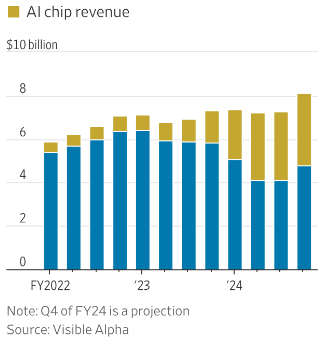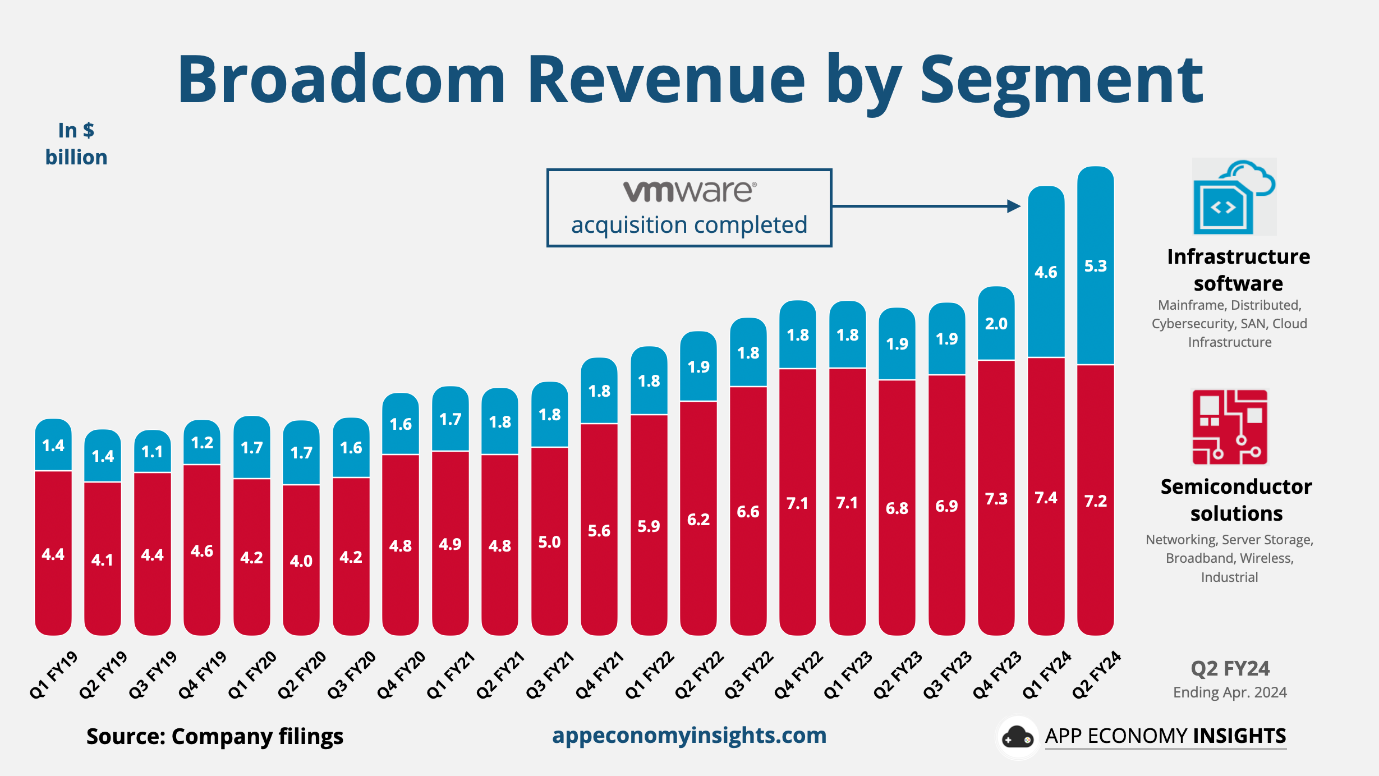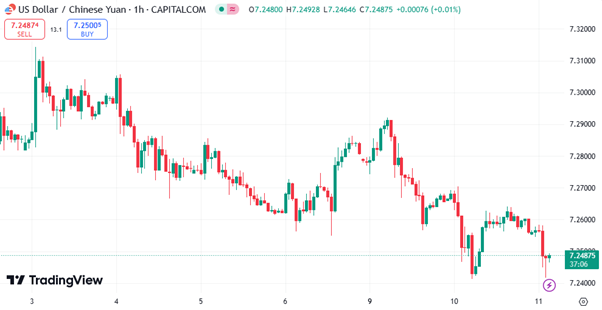市场资讯及洞察
.jpg)
量子计算:和平年代的“核武器”,以及赛道上的7大玩家
提到“核武器”,大家想到的是改变战争格局的终极威慑力;而在没有硝烟的和平年代,量子计算正成为新的“战略王牌”。
它不靠爆炸力,而是靠指数级算力重塑科技、经济、安全的底层逻辑。谁先掌握它,谁就能在新药研发、信息安全、新能源等领域抢占先机。
这是一场没有硝烟的“量子军备竞赛”,而谷歌、IONQ等公司,就是这场战争的主角。
一、为什么说量子计算是和平时期的“核武器”?
普通电脑像“单线程快递员”,一次只送一件包裹;
量子计算靠“量子比特分身术”,能同时处理海量信息——10个量子比特就能同时计算1024种状态。
这种差距,不是“快一点”,而是“维度不同”:就像骑自行车去追火箭。
它能干的事堪称“颠覆级”:
· 破解银行、互联网加密系统(别人算几百年,它几小时搞定)
· 模拟分子结构加速药物研发(几年缩成几个月)
· 优化交通、金融、能源系统(让全球效率更高)
所以,谁掌握量子计算,谁就能制定未来的技术规则和安全标准。这份话语权,正如核武器之于国家安全一样。
二、赛道上的7大玩家:谁在领跑?
1. 谷歌(GOOGL)——超导路线的“火箭选手”
谷歌是量子计算的顶流。
它的超导芯片“Willow”已经做到105个量子比特,速度比全球最快超算还快1.3万倍。
它能计算分子结构,加速新能源电池和抗癌药研发。
谷歌放话:5年内实现实用化应用。
短板也有:超导量子比特太“娇气”,要放在比南极还冷几百倍的环境里,目前还只能处理特定任务。但作为科技巨头,谷歌的资源和研发速度,让它仍是最有可能先造出“量子核武”的玩家。
2. IONQ——离子阱路线的“精密工匠”
IONQ用激光“抓住”带电原子作为量子比特,精度极高、错误率低。
它靠32个量子比特就宣称实现“量子优越性”,比谷歌还早一步。
现在专攻“量子纠错”,让运算更稳定,是迈向实用的关键。
缺点是难以扩展,加一个比特像往积木塔上叠块砖,容易影响整体。
但在科研模拟、精密计算等领域,它的“精准”优势明显,有望后来居上。
3. 霍尼韦尔(HON)——幕后“装备大佬”
霍尼韦尔虽然不出风头,但它的子公司Quantinuum是离子阱路线的中坚力量。
更重要的是,霍尼韦尔的激光器、制冷系统、测控设备,是全球量子实验室的标配。
它是量子领域的“军工厂”,不造火箭,但造发动机。
在未来的产业链中,它是所有玩家都离不开的“幕后功臣”。
4. QUBT——专做“量子安全”的锁匠
QUBT不做量子计算机,而是做防量子破解的安全加密。
它利用量子技术生成不可预测的密钥,给数据上“防量子锁”。
银行、政府机构已经在用它的产品。
未来量子计算能破解传统加密,而QUBT的锁正是抵御“量子黑客”的盾牌。
算是最贴近普通人生活、最早能变现的应用方向。
5. QBTS——“软件+硬件”的小众探索者
QBTS采用特殊的核磁共振技术,在常温环境下也能运行,不用极冷设备。
目前算力较弱,主要帮企业做物流规划、路线优化等小型任务。
虽然不是“超级计算怪兽”,但胜在灵活低成本,可能在特定场景率先落地。
6. Rigetti(RGTI)——被巨头甩开的追赶者
RGTI走超导路线,推出过80比特设备,但进展放缓。
现在主攻“量子云平台”,让企业租算力做实验。
只是面对谷歌、IBM的强势,它的技术差距越来越大,市场声音也逐渐变弱。
7. Laser Photonics(LAES)——“量子副业”的蹭热股
LAES主业是激光设备,量子只是“副业”。
偶尔宣布要搞“光量子技术”,但没有实际芯片或数据。
目前更像是“站在量子赛道边上的观察员”,未来潜力有待验证。
三、我们应该关注什么?
不能以为这只是科研人员的游戏。量子计算未来影响的是你我的生活:新药更快上市,电动车续航更高,网络支付更安全,物流更智能。
如果要关注投资方向或应用落地:
谷歌:技术最强、速度最快,五年内可能看到实用成果;
IONQ:纠错领先,科研和精密行业潜力大;
QUBT:防量子黑客的“安全护盾”,最贴近现实场景。
四、结语:量子“军备竞赛”才刚开始
量子计算不是“更快的电脑”,而是和平年代的核武器。它决定未来科技的主导权,也重塑国家竞争格局。
现在的玩家,有的快、有的稳、有的专,但真正的胜者,取决于谁能先跨过“纠错”和“可扩展”这两道坎。
十年后,你用的药、开的车、上的网,背后可能都有量子计算的力量。这场“无声的军备竞赛”,正在改变人类的未来。


热门话题
上周美国CPI符合预期,PPI超预期反弹,上周五股指未能大幅冲高,道指七连跌后收下连续第二周下行,标普收平,周级别也有微弱回调,仅纳指收涨持续保持强势。三大股指的分化再次显现,本轮AI发力拉动纳指是持续关键因素,但已不局限于AI基础层,AI应用正在快速崛起,上市公司财报受AI应用带动的现象开始体现,博通财报并不突出,但AI营收大幅增长令股价周五收涨24%,而ADBE财报指标均好于预期,仅业绩展望未能达到市场预期而暴跌。特朗普胜选后,马斯克作为最大赢家进一步稳固首富地位,效果立竿见影,特斯拉股价节节攀升,于是就有了扎克伯格去拜访特朗普拉近关系,周末库克也去了特朗普庄园拜会,几大科技巨头纷纷站队表态,为25年美国本土科技巨头的进一步顺利发展铺平道路。本周作为美国消息大周,将为2024年美股怎样收尾定下基调。零售销售月率,美联储利率决议,鲍威尔新闻发布会,美国实际GDP修正值,以及核心PCE物价指数都将陆续公布。从预测数据看,本周美元又将被强势拉升,美国经济的强势将被进一步验证,前半周股市自然也不会差,后半周核心PCE数据预期会有反弹,对股市构成一定利空。

板块方面美股周五跌多涨少,半导体一枝独秀,人工智能和科技板块上涨,非必消品和公共事业微弱收涨,金融板块小跌,铀矿,铜矿和稀土等资源板块跌幅较大。美国几大核技术股仅NNE测试MA10成功并反弹,OKLO和SMR周级别均破位。关于铀矿本身,加拿大铀矿公司或因两国关税政策的影响而被打压,国际铀价有望再度被炒高,但加拿大铀矿公司业绩或受到明显影响,CCJ和NXE周五股价均有明显下跌,当然特朗普对加拿大是否征收25%关税还未落地,一切皆有变数。PLTR,MSTR和AXON新入纳指100有望进一步推高价格。特斯拉股价继续大幅收高冲击$500,2025年特斯拉上升空间在七巨头中是最大的。美元周五小幅下跌,本周预计将强势反弹,金价承压扩大跌幅,目前已经跌破2650平台,恐慌上半周依然看空,油价扩大涨幅,美油如期冲上71大关并有望靠近震荡压力位73平台。外汇方面澳元持续低迷,本周汇市依旧是美元为中心,澳美目前看较难走强了,美日本周有望重回155平台,美元人民币本周也有望测试前压力7.3平台。免责声明:GO Markets 分析师或外部发言人提供的信息基于其独立分析或个人经验。所表达的观点或交易风格仅代表其个人;并不代表 GO Markets 的观点或立场。联系方式:墨尔本 03 8658 0603悉尼 02 9188 0418中国地区(中文) 400 120 8537中国地区(英文) +248 4 671 903作者:Xavier Zhang | GO Markets 高级分析师


This article provides an in-depth analysis of potential market drivers, sector-specific performance expectations, global trends shaping the investment horizon for the year ahead, and amongst other factors, the potential impacts of a U.S. presidential transition. Within this analysis we will suggest what our provisional projection is and stocks that we think may benefit through 2025 and are perhaps worth some consideration providing of course they are a fit for your specific trading plan, personal objectives and financial situation, The Current State of Equity Markets Since the global pandemic and subsequent hyperinflation, equity markets have had a tumultuous few years, Add to that the continued influence of geopolitical tensions, many leading economists and arguably most market participant the reality is that al always, “the market, does what the market does” and as of late 2024, major indices such as the S&P 500 and the MSCI World Index are trading near record highs. In the U.S., the S&P 500 to date in 2024 is up a very impressive 26%, buoyed by continued earnings growth, the “artificial intelligence (AI) factor, and softening Federal Reserve, European equities lagged the US, but still gained with the FTSE hitting record highs in May and up around 8% year to date, and in Australia, an all-time high of 8514.50 in December of 2024, and showing a gain of close to 10% in 2024.
Resilience in the U.S. economy, a much “softer landing” (and avoidance of recession) than many had predicted in a high-interest rate environment, and very strong corporate earnings evidenced recently have all seen buying pressure predominate in stocks. There are potential headwinds looming, with some uncertainty obvious as we get close to the end of the year. Some central banks remain reluctant to cut rates (e.g.
The Reserve bank of Australia), and continued Chinese fiscal stimulus is perceived by markets to be a necessity rather than a luxury in terms of retaining a reasonable level of growth. Key Drivers for Equity Markets in 2025 Monetary Policy Shifts Central banks worldwide, particularly the Federal Reserve, will play a pivotal role in equity market performance. Further aggressive rate cuts in late 2025 could provide a tailwind for equities, particularly growth-oriented sectors such as technology.
We are still above the target inflation of 2-2.5%, which appears to perhaps be paused at this stage which means a cautious approach in the early part of year is likely. Inflation and Consumer Spending Moderating inflation, and so interest rates could enhance consumer purchasing power, boosting retail, travel, and leisure stocks. However, persistent wage pressures may challenge profit margins in certain industries.
Probably, the most unknown, and potentially most feared is that of the impact of potential import tariffs from the new Trump administration. These are seen as both inflationary, due to the impact on the cost of imported goods into the US, and may be likely to slow growth as a result of this and the indirect impact on potential rate cuts and subsequent cost of living impact on the US consumer. Corporate Earnings Earnings growth expectations for 2025 remain positively modest, but supportive of continued quarter on quarter growth through the year.
Current growth on last earnings forward guidance is suggested to be 5.7% for the 12 months ahead, with analysts projecting a 6-9% increase for S&P 500 companies for the year. The changing political environment in the US will obviously be influential, not only in terms of direct impact of policy e.g. the increase in oil production, but also the impact of persistent inflation on corporate lending, and consumer spending are all important. Geopolitical and Regulatory Factors Trade tensions, particularly between the U.S. and China, could impact sectors such as industrials and semiconductors.
We have already seen evidence of the latter in the last week. Additionally, environmental, social, and governance (ESG) regulations will influence investment flows in Europe as well in the US. The Middle-East conflict and the Russia-Ukraine situation, if persisting or even some escalation are all threats.
U.S. Presidential Transition With a potential change in the U.S. administration, pre-election suggestions of policy shifts in areas such as taxation, import tariffs, infrastructure spending, and a reduction in green energy initiatives could significantly impact sector performance. Dependent of course on whether we see follow through on that which was promised, and the timing of such will obviously be a key factor.
Sector Opportunities for 2025 Technology The technology sector is poised for continued growth, driven by advancements in artificial intelligence, cloud computing, and semiconductor demand. Companies like NVIDIA, Microsoft, and Tesla are leading innovation in generative AI and automation. Semiconductor stocks such as AMD and Taiwan Semiconductor Manufacturing Company (TSMC) are expected to benefit from rising chip demand.
Healthcare Aging populations in developed markets and innovation in biotech and pharmaceuticals present strong growth opportunities. Companies such as Johnson & Johnson, Moderna, and Illumina are well-positioned to capitalize on advancements in telemedicine and personalized medicine. Energy Transition Clean energy stocks are likely to benefit from government incentives and increasing global emphasis on reducing carbon emissions.
SolarEdge Technologies, First Solar, and Tesla stand out as potential winners. However, the Trump administration's rejection of evidence of global warming and a desire to support the more traditional carbon based energy sources may decrease potential growth in US based renewable energy stocks. Consumer Discretionary As inflation moderates, discretionary spending could rise, benefiting sectors such as travel, luxury goods, and e-commerce.
Companies like Amazon, Nike, and hotel and travel stocks e.g. Marriott International, are positioned to capitalize on these trends. Strong brand equity and innovation in customer experience will differentiate winners in this space.
Industrials and Defence With ongoing geopolitical tensions, defence spending is expected to remain elevated, benefiting aerospace and defence contractors such as Lockheed Martin, Raytheon Technologies, and Boeing. Infrastructure investments, if there is policy support for such, will also drive growth in construction and engineering firms, e.g. Caterpillar, who continue to produce excellent company reports.
Materials stocks Many resource stocks are global irrespective of the exchange (or often multi-exchange) they trade on e,g, BHP. There is no doubt that any slowdown in China is likely to impact demand for resources and influence manufacturing. Despite evidence of recent stimulus in the Chinese economy, many remain sceptical about the impact without further increases in such.
There is also little doubt that the “Trump Tariffs”, will impact, dependent of course as to the actual roll out of these, Although the cost of such will be worn by the US importer and not by the overseas company in simple terms, the indirect impact of potential need to drop prices to sell or looking elsewhere if local sources are not found may influence not only Chinese exports but also those companies who supply the raw materials to help make this happen. The impact on global materials stocks could be significant Global Trends and Regional Insights Europe Europe’s equity markets face headwinds from slow growth and energy dependency. However, opportunities exist in green energy and industrials, supported by the EU’s more aggressive green transition agenda than is the case in the US.
Companies such as Siemens and Vestas Wind Systems are well-positioned. Emerging Markets Emerging markets, particularly in Asia, hold long-term promise but face short-term risks from higher interest rates and currency depreciation. China’s reopening and policy stimulus could provide a boost, especially in consumer and technology sectors.
Alibaba and Tencent are expected to benefit from a domestic demand recovery. Australia Though corporate earnings have remained strong and the index hit record highs this month, there is a continued reluctance of the RBA to cut rates is now likely to extend well into 2025, with February at the earliest, and some even suggesting that Q2 is more likely, predicted amongst analysts, This does threaten growth in consumer discretionary stocks. The other potential headwind, as previously discussed, is the indirect impact of US tariffs imposed on China, not only in terms of demand for exported goods and so manufacturing, but on global commodity prices e.g., copper.
Hence the large materials sector may struggle at times dependent on the extent of these. Japan Japan’s markets have shown strength, driven by structural reforms and increased shareholder focus. Export-oriented industries, particularly automotive and robotics, are well-positioned for growth.
Companies like Toyota and Fanuc are strong contenders. The potential additional rise in Japanese interest rates which the market is expecting this month or January 2025 may impact not only on local stocks but could impact globally due to the carry trade implications, 10 Stocks to Watch in 2025 The following could benefit from some of the tailwinds discussed above, may outperform the market as a whole, and may prove resilient if the economy is not quite as robust as many think All of the following are tradable on GO Markets MT5 platform as Share CFDs. FIVE U.S.
Stocks: NVIDIA (NVDA): Leading advancements in AI and GPUs, NVIDIA remains at the forefront of technology innovation, poised to benefit from continued investment in generative AI. Microsoft (MSFT): Strong growth in cloud computing and AI-driven services ensures Microsoft’s leadership in technology. Tesla (TSLA): Beyond EVs, Tesla’s energy storage and clean energy initiatives position it for growth in multiple sectors.
The relationship between CEO Elon Musk and incoming President Donald Trump is not likely to do any harm to policy support of Tesla. Carnival Corp (CCL): With price back to levels not seen since the pandemic, an improving earnings and debt reduction story and the potential for consumer discretionary stocks to outperform should there be continued rate cuts later in 2025, this cruise stock could benefit. Caterpillar (CAT): Infrastructure investments, evidence of continued strong corporate performance and general industrial growth suggest Caterpillar could be a strong performer in the industrials sector.
FIVE ASX Stocks: Block Inc (SQ2.asx.): US company trading on the ASX who bought “Afterpay” to add to its global portfolio. Life 36) Inc. ( 360.asx ): Another US based company who also trades on the local market, This family app has shown strong growth and recent earnings support all-time highs on the stock, which continues to look positive into 2025. Deep Yellow (DYL): Uranium stocks have looked strong in the latter half of 2024 and despite the recent pullback followed by a price move higher, price seems to be “at value”, particularly with the increase in Japanese nuclear energy commitment and a global (ex-US) desire to move to decarbonisation.
DYL is well positioned to benefit from this during 2025. Webjet Travel Group (WEB): Webjet is a different entity to that which started 2024 with a split into two separate companies. Webjet travel group will benefit from increased consumer spending through 2025, which although may not happen significantly into at least Q2 2025, the company balance sheet is good and this stock looks as though it is well positioned at this current price to have a positive 2025 even if investors have to be patient initially.
Yancoal Australia Ltd (YAL): Operating five coal mines and managing five others across New South Wales, Queensland and Western Australia, YAL is potentially well placed in this sector to benefit in 2025. After reaching an all-time high this year, global coal demand is expected to remain as is, and so longer than expected, before a decline in 2026, according to the latest edition of the International Energy Agency's (IEA) annual coal market report. This would support a move higher during the coming months.
Particularly if we see a breach of July highs of $7.40. Summary: Navigating Equity Markets in 2025 The equity markets in 2025 will likely be shaped by a delicate balance of macroeconomic, sectoral, and geopolitical forces. Investors should remain agile and open to potentially quick changes in market sentiment and be prepared for some form of sector rotation throughout 2025.
The potential impacts of U.S. presidential policies add another layer of complexity, requiring vigilance and adaptability. Diversification across regions and industries, as well arguably similar diversification of approaches (i.e. some short-term, others medium-long term), may also be prudent, As always, our education through Inner circle and daily updates with charts of the day, could be a good place to be not only to be informed but also assist in assessing risk and opportunity throughout the coming year.


Trading is a skill that requires continuous development, self-assessment, and refinement. For traders aiming to achieve consistent profitability and long-term success, following a structured process can make the difference between stagnation and mastery. In this article, we’ll explore a systemized five-step process for trading development, designed to help you identify gaps, take ownership of your growth, and implement effective strategies.
Additionally we will discuss not only why traders avoid this approach (including a checklist) and what YOU can expect if you follow through on some of the methods used Why This Approach Is Often Overlooked While the systemized approach to trading development is logical and proven, it remains unpopular among many traders. This is largely because it requires introspection, effort, and patience—qualities that often take a backseat to the allure of quick fixes. Many traders fall into the trap of chasing the "next big strategy" or the "magic bullet" that promises instant success without the need for sustained effort.
Reasons Why Traders Avoid This Approach: - Impatience: The desire for immediate results often overshadows the commitment required for gradual improvement. - Overconfidence: Many traders believe they can succeed without addressing fundamental gaps, relying solely on luck or intuition. - Fear of Failure: Self-assessment can be uncomfortable and may reveal mistakes or shortcomings that traders prefer to ignore. - Lack of Awareness: Some traders simply don’t recognise the value of a structured development process or don’t know how to start. - Shiny Object Syndrome: The constant search for new strategies and tools distracts from the need to refine existing skills and processes. - Time Constraints: Trading development requires time and effort, which may seem daunting when balancing other commitments. Checklist: Are You Avoiding This Process? - [ ] Do you often jump to new strategies without fully mastering your current one? - [ ] Do you avoid reviewing your past trades and learning from mistakes? - [ ] Are you more focused on finding a winning indicator or strategy than improving your discipline and execution? - [ ] Do you feel uncomfortable facing your trading weaknesses? - [ ] Have you neglected setting clear goals and benchmarks for your trading? - [ ] Do you feel you lack the time to dedicate to structured development? If you checked any of the above, it’s worth reconsidering your approach.
A systematic process may seem less exciting, but it’s the cornerstone of long-term success. Your FIVE steps to trading development We have identified FIVE key areas of work to help you take your trading to the next level. Within each we have identified actions and suggested potential resources to help in your development journey.
Step 1: Benchmarking Gap Analysis Objective: Evaluate where you currently stand versus where you need to be in three key domains: technical skills, risk management, and psychological discipline. Steps: Assess Your Current Performance: Analyse your trade history, win/loss ratio, average return per trade, and consistency over time. Identify patterns in your trading (e.g., frequent stop-outs, giving too much back to the market on profitable trades, over-leveraging).
Define Your Ideal State: Identify those situations where you shouldn’t trade eg, when unwell, or routines you can put in place that will help you focus as soon as you look at your first chart of the day eg, realign with your trading plan. Specify what consistent profitability looks like for you. This might include metrics such as a 3:1 reward-to-risk ratio, an 80% adherence to your trading plan, or minimising emotional trades.
Conduct a Comparative Analysis: Pinpoint gaps in your knowledge, execution, or mindset. Ask yourself tough questions: Are you trading with discipline? Are your strategies well-tested?
Do you have a proper risk management plan? How to Achieve It: Use tools like trade journaling software, analytics platforms, or even manual spreadsheets to document and evaluate performance. Consider seeking out mentorship or coaching to gain an external perspective on areas for improvement.
Be honest with yourself. Acknowledging and owning areas of weaknesses is the first step toward progress. Step 2: Identification and Prioritization of the Gap Objective: Isolate the most critical gaps and prioritize them based on their impact on your results.
Actions: Categorize Your Gaps: Knowledge Gaps: Lack of understanding of market conditions, indicators, or trading strategies. Execution Gaps: Poor timing, impulsive decisions, or failing to follow your plan. Psychological Gaps: Fear of loss, overconfidence, or inability to manage stress.
Rank Gaps by Priority: Focus on the gaps that directly affect profitability or pose the highest risk to your account. For example, improper risk management may take precedence over optimizing your charting skills. How to Achieve It: Conduct a SWOT analysis (Strengths, Weaknesses, Opportunities, Threats) specific to your trading.
Use performance metrics to quantify the severity of each gap (e.g., how many trades are lost due to poor discipline?). Limit your focus to the top 2-3 gaps to avoid overwhelming yourself. Step 3: Ownership and Plan Clarity Objective: Develop a clear, actionable plan and commit to executing it with accountability.
Action: Create Specific Goals: Example: “Improve adherence to my trading plan from 80% to 90% over the next month.” Break Down the Plan: Define daily, weekly, and monthly tasks. For instance: Daily: Review and refine your watchlist. Weekly: Analyze trade outcomes and adjust strategies.
Monthly: Evaluate progress against set benchmarks. Identify Required Resources: Educational materials (books, courses, webinars). Tools (backtesting software, risk calculators, journaling platforms).
Support systems (accountability groups, mentors, or trading communities). How to Achieve It: Use SMART goals (Specific, Measurable, Achievable, Relevant, Time-bound) to structure your plan. Establish accountability through regular check-ins with a trading partner or coach.
Create visual reminders (e.g., a whiteboard or app) to keep your plan front and centre. Step 4: Learning and Development in Real-Time Objective: Apply your learning to live or simulated markets to reinforce skills and refine strategies – then take LIVE action. Actions: Using a Demo Account for new approaches: Practice executing trades under realistic market conditions without risking real capital.
Setting up a “ghost account” alongside your LIVE account which can be used to test new strategies or see the impact of scaling before you do it in practice (so you get psychologically ready for those bigger profit and loss numbers) Have set criteria for when you will transition to live trading to reduce the chance of procrastination for taking your next step. Use a Trade Journal: Record every trade with details such as entry/exit points, rationale, outcome, and emotions. Analyse trends over time to uncover recurring mistakes or successful behaviours.
Embrace Feedback: Treat mistakes as learning opportunities. Ask, “What went wrong, and how can I fix it?” Review your trades weekly to identify progress and areas requiring further improvement. How to Achieve It: Simulate market conditions closely aligned with your trading style (e.g., day trading or swing trading).
Join forums or groups where traders share insights and feedback. Commit to a growth mindset: mistakes are inevitable but invaluable for learning. Step 5: Testing, Implementation, and Refinement Objective: Measure your progress, refine your strategies, and ensure a continuous cycle of improvement.
Steps: Test Against Key Metrics: Evaluate progress using your ‘results barometer’ (e.g., profitability, win rate, risk management adherence). Close the measurement circle: Make data-driven decisions to tweak your strategies or execution plans. For instance, if a strategy has a low win rate, analyse whether the issue lies in the strategy itself or its implementation.
Create a Feedback Loop: Revisit Steps 1-4 periodically to ensure continuous alignment with your goals. How to Achieve It: Set milestones (e.g., quarterly reviews of your trading results). Use A/B testing for strategies to compare performance under different conditions.
Celebrate small wins to maintain motivation. So If I Do These Five Stages, What Can I Expect in My Trading Performance? By committing to these five stages, you can logically expect a transformational shift in your trading.
Systematic development not only addresses gaps in your skills but also enhances your confidence and decision-making abilities. Here are the key benefits and reasons why this is the primary driver for action: 1. Improved Consistency: - Following a structured approach reduces impulsive and emotional trading decisions, helping you stick to your plan. - With refined strategies and clear benchmarks, your results will become more predictable over time. 2.
Enhanced Risk Management: - Identifying gaps in your approach allows you to minimise unnecessary risks and protect your capital more effectively. - A systematic process ensures that every trade is backed by sound risk-reward calculations. 3. Data-Driven Decision Making: - Regular review and analysis of your trades ensure that you’re making informed decisions based on evidence rather than guesswork. Commit the principle of “evidence based trading” to everything you do from here, 4.
Increased Confidence: - Knowing that you have addressed weaknesses and built a solid foundation instills greater confidence in your trades. - This confidence helps you remain calm and disciplined, even in volatile markets. 5. Continuous Growth: - The feedback loop ensures that you’re always learning and adapting to changing market conditions. - This adaptability is crucial for staying competitive in the long term. Ultimately, it is an unavoidable fact that the primary driver for taking action lies in the fact that trading success is not about finding shortcuts but about building sustainable habits and systems.
By embracing this process, you’ll not only give yourself a chance to improve your results but also develop the resilience and mindset required to thrive as a trader. Summary Trading is not a one-time skill but a lifelong journey of learning and adaptation. Through following this five-step systemized process, you can take greater control of your development, systematically address your weaknesses, and build on your strengths.
Success in trading doesn’t come from luck but from deliberate effort, discipline, and continuous refinement. Take the first step today, and remember: the best traders are always students of the market. And finally, we are here to help.
Our regular education sessions and videos are there to guide you, offering detailed explanation and clarity about many of the things covered in this article.


热门话题
根据12月11日The Information报道,苹果将与博通(AVGO.NAS)将合作研发一款代号为Baltra的AI芯片,交由给台积电制造,预计2026年实现量产。目前各大互联网巨头在布局自研芯片以降低对英伟达等厂商的依赖,继谷歌和Meta之后,博通与苹果的新合作无疑给投资者打了强心针。当天,博通股价涨超6%,台积电股价也微涨1%左右。博通于今早美股盘后发布了Q4业绩报告,不出意料的让投资者满意。截至11月3日的Q4财报基本超预期,营收同比增长50%,Diluted EPS $1.42高于分析师预期的$1.38,AI业务收入暴涨220%,在此带动下,给出2025年业绩指引基本符合市场预期。盘后股价一度暴涨15%,扭转了盘中1.4%跌幅,我们期待今晚美股开盘后的表现。

博通是一家以“并购-整合-再并购”策略著称的全球顶级半导体公司,今年以来股价上涨78%,近三年股价上涨426%,目前市值超8000亿美元。通过对博通的业务结构、主要增长点以及未来发展预期的分析,我们可以看出其在半导体和软件服务领域的稳健发展势头。业务板块方面,AI业务和VMware软件业务仍是主心骨。博通的半导体业务覆盖网络、存储连接、宽带、无线通讯等领域,整体板块的增长主要由AI业务引领,而非AI板块增速近两年有所下滑。借助ASIC(特定应用集成电路)技术,博通已经与谷歌和Meta等科技巨头建立了合作关系,其定制芯片已进入量产阶段,只要两家维持相当的资本开支力度增速,博通AI收入增长将有保障。目前,各投行预计2025年科技巨头AI资本支出增速将保持平均20%左右,博通AI的收入增长仍然有望实现20%+。

软件业务方面,博通于2023年完成对VMware的收购,通过外沿收购强化在虚拟化软件市场的领导地位。VMware是虚拟机市场的领军企业,全球用户数超过30万,全球财富TOP50企业超半数使用期服务,2021年VMware在非公有云虚拟化软件市场份额高达92%-97%。博通收购后采取了诸如收费模式转为SaaS订阅模式、精简经销商渠道等变相“涨价”措施。这些调整提高了VMware的收入能力,随着订阅收费模式的全面推广,有分析师预计VMware业务2025年收入将达到170亿美元,同比增长40%。

业绩展望方面,在AI业务和VMware整合的推动下,博通2025财年核心经营利润预计达到336亿美元,同比增长38%。到2026年,预计核心经营利润将达到401亿美元,同比增长19%。机构预计,2025年博通将完成消化收购VMware带来的利润摊销影响,使其2025年整体毛利率有望持续提高。同时,研发和销售费用率有望进一步降低,助力公司实现利润增长,华尔街分析师大多对博通表示继续看好,摩根大通预计EPS将在2025年增长28%达到$6.34,而收入将同比增长17%。当前公司前瞻估值约30倍,比竞争对手英伟达33倍略低。博通通过不断并购实现了“打怪升级”,没有的业务通通买回来整合,目前已成为可以与英伟达打擂台的半导体巨头。伴随着纳指终于在2024年尾声时20000点打卡成功,博通凭借其在核心领域的技术优势,有望在未来数年内保持增长势头并且为投资者带来稳定回报。未来,随着AI和云计算的持续扩展,博通的增长故事仍将延续。免责声明:GO Markets 分析师或外部发言人提供的信息基于其独立分析或个人经验。所表达的观点或交易风格仅代表其个人;并不代表 GO Markets 的观点或立场。联系方式:墨尔本 03 8658 0603悉尼 02 9188 0418中国地区(中文) 400 120 8537中国地区(英文) +248 4 671 903作者:Christine Li | GO Markets 墨尔本中文部


As we examine what may happen in the new year, it is clear that gold continues to be of interest for investors seeking stability, diversification, and opportunities amidst what is likely to be an interesting and changing economic landscape throughout 2025. With a change in the US presidency, significant central bank action likely, and on-going geopolitical concerns likely to rumble on, may all have significant impact on markets generally including, of course, what may happen to precious metals. This article explores the potential trajectory of gold prices in the upcoming year by examining these key factors driving its value, the headwinds and tailwinds shaping its path, and what the current state of gold indicates for its future.
The Current State of Gold Gold has been on a dynamic journey in recent years, reacting to a mix of macroeconomic pressures and geopolitical events. As of now, and after hitting record highs late October just beneath $2,800, gold futures prices are approximately $2,700 per ounce, remaining in long-term uptrend, and reflecting a year of relative volatility influenced by central bank policies and persistent inflation concerns. Inflation in the U.S. remains elevated, with the Consumer Price Index (CPI) year-over-year as of late 2024.
Although down from the 9.1% peak in 2022, inflation pressures are still stubbornly above the Federal Reserve’s 2% target, and appear to have paused at the current time. This persistent inflation has encouraged some investors to allocate capital into gold as a hedge, contributing to its stability. In 2024, gold’s performance was shaped by factors such as the Federal Reserve’s interest rate hikes, geopolitical tensions like the ongoing Russia-Ukraine and Middle-east conflicts, and strong central bank purchases.
These elements set the stage for 2025, where uncertainties around monetary policy, global stability, and demand dynamics will likely play crucial roles. What Moves Gold Prices -- Key Drivers to Watch Gold's value is influenced by a combination of fundamental and technical factors. Here’s a deeper dive into the primary drivers: Macroeconomic Influences Gold’s price tends to rise during periods of high inflation or economic uncertainty.
Historically, during the stagflation of the 1970s, gold surged as investors sought protection against eroding purchasing power. Conversely, rising interest rates often reduce gold’s appeal, as seen in the early 1980s when rates reached double digits, causing gold prices to decline. Geopolitical Events Gold is a classic safe-haven asset, often gaining during periods of global instability.
For instance, during the 2008 financial crisis, gold prices spiked as investors fled riskier assets. Similar behaviour was observed during the early months of the COVID-19 pandemic in 2020. More recently events in the Middle East saw more gold buying in 2025.
Currency Dynamics Gold typically moves inversely to the U.S. Dollar. A strong dollar, as seen in 2022, can suppress gold prices, while a weaker dollar, such as during the 2010-2012 period, supports gold’s rise.
The US is rising again on a perception that further rate cuts in 2025 are less likely than perhaps thought a couple of months ago. Supply and Demand Fundamentals Supply-side factors, including mining output, have remained relatively stable in recent years. On the demand side, central bank purchases hit record highs in 2023, with countries like China and Turkey significantly increasing their reserves.
The World Gold Council reported that central banks purchased over 1,000 tonnes of gold in 2023, the largest annual total since records began in 1950. Notably, China added over 200 tonnes to its reserves, reflecting its strategy to diversify away from the U.S. Dollar.
Jewellery demand from India and China remains another part of gold’s value although arguably less so than perhaps other factors discussed above. Industrial and Technological Use Gold’s role in electronics and green energy technology, such as photovoltaic cells in solar panels, continues to grow, adding a layer of industrial demand. However the new US administration that will be in place from January, appears to be less keen on renewable energy which may curb this to some degree Headwinds for Gold in 2025 While gold has potential for growth, several challenges could limit its upside: Rising Interest Rates: If central banks, particularly the Federal Reserve, maintain or further increase rates, the opportunity cost of holding gold becomes higher.
Higher rates make bonds and savings accounts more attractive compared to non-yielding assets like gold. Strong U.S. Dollar: A resilient dollar, supported by higher interest rates or strong U.S. economic performance, typically reduces gold’s appeal for international buyers.
The U.S. Dollar Index (DXY) remained strong in 2024, trading above 105 for much of the year. Equity Market Resilience: A robust stock market could divert capital away from safe-haven assets like gold.
For example, during the tech boom of the late 1990s, gold underperformed as investors flocked to equities. Geopolitical Stability: If global tensions ease, the safe-haven demand for gold may diminish. Stable geopolitical conditions often correlate with a decline in gold prices, as seen during the mid-2010s.
However at this stage, there are several potentially volatile situations that may be of impact through next year. Tailwinds for Gold in 2025 Several factors could bolster gold’s performance: Inflation Pressures: Persistent inflation, even if moderated from 2024 levels, could drive demand for gold as a hedge. Historical parallels can be drawn to the 1970s, when inflation pushed gold to record highs.
For instance, gold surged from $35 per ounce in 1971 to over $600 by 1980 as inflation spiralled out of control. The new Trump administration continues to Central Bank Buying: Central banks added nearly 1,000 tonnes of gold to their reserves in 2023, a trend likely to continue in 2025. This significant demand underpins long-term price stability.
Countries like Turkey and China remain active buyers, viewing gold as a hedge against currency devaluation and geopolitical risks. Market Volatility: Heightened risks, whether from an economic slowdown or geopolitical shocks, could renew safe-haven flows into gold. With the follow through and potential impact of some of the new US government policies as yet unknown but “promised” during pre-election, there is the narrative that these may dampen down growth in the short term.
Of course, there is an often wide disparity between pre-election promises and reality and the underlying economic metrics, both in terms of data and the recent overperformance of US company earnings (over 75% beating expected EPS), are suggesting that any fall off is unlikely). Weaker U.S. Dollar: If the Federal Reserve continues with the late 2024 approach to rate cuts, the dollar is likely to weaken, supporting gold prices.
However, the decreasingly “dovish” narrative that has been prevalent in the last few weeks suggest a potential pause in rate cut action during early 2025. Technical Analysis: Where is Gold Headed? From a technical perspective, gold’s price action will be pivotal in determining its outlook: Support Levels: Key support zones around $2.600 and more importantly perhaps the mid-November low of $2,535 will be crucial in maintaining bullish sentiment.
A breach of the latter is likely to suggest a change in longer term trend and could precipitate more selling pressure. Resistance Levels: Overcoming previous highs at $2,800 could open the door to new highs, with $3,99 as the next significant target both technically and psychologically for markets. Forward-Looking Analysis: the FIVE key questions Breaking down the above into the key questions that will shape gold’s outlook in 2025: Will the Federal Reserve continue to cut interest rates, or will inflation remain stubbornly higher than desired (particularly influenced by any “Trump Tariffs”) support USD strength and derail the current trajectory of inflation?
Could geopolitical risks resurface, reigniting demand for safe-haven assets including gold? What role will central bank, speculative and institutional activity play in driving prices? How will the demand from emerging markets and technology and renewable energy sectors evolve?
My personal “Flag planting” for 2025 is that although we may be likely to see a ceiling of 2800 in the early couple of months of 2025, with uncertainty and perhaps a “foot off the pedal” approach” relating to Federal Reserve action and a new US administration, it would take something significant in the data to push Gold to, and through $2550. The evidence points to a potentially strong 2025 subsequently and a serious test of $3000 looks on the cards as a strong potential. Summary: Navigating Gold’s Path and your approach in 2025 Gold remains a multifaceted asset, influenced by a complex interplay of economic, geopolitical, and technical factors.
As we navigate 2025, investors must stay attuned to shifts in monetary policy, global stability, and demand trends to make informed decisions. Whether as a hedge against uncertainty or a strategic investment, gold’s enduring appeal ensures its relevance in the year ahead. Your responsibility as a trader or investor is twofold: Keep abreast of changes in those influential factors outlined above, and offer daily and regular updates on all major assets classes, including gold, to avail yourself with the knowledge you need to make the decisions that are right for you and your objectives, Consider alternative ways to trade gold, e,g, gold futures and share CFDs offer the opportunity to trade long or short so you can take advantage of any move, Of course, the former also has the distinct advantage of being “open” throughout the 24-hour period meaning you can respond to changes in a timely way rather than waiting until the next “market open” for stocks.


热门话题
近期如果关注全球货币市场的各位可以发现,全球范围内的货币政策逐渐走出了分化的趋势,尤其是美联储的降息步伐更是受到广泛的关注。尽管目前市场大部分的态度依旧是预测十二月份美联储会继续降息,但部分分析师和美联储官员依旧保持观望态度。所以我们今天就来讨论一下,在全球经济增长放缓的今天,美联储和各大经济体的货币政策都会对资本市场产生怎样的深远影响。自2024年中期以来,美联储试图通过多次降息来应对经济增长放缓。然而,随着就业市场逐渐稳健以及对通胀风险的担忧,美联储是否会放缓降息步伐成为市场关注的焦点。

近期数据表明,美国核心通胀率依然高于目标水平,并且华尔街高盛认为一旦特朗普的关税计划得以实施,PCE的核心通胀读数可能会提高近1%。所以尽管市场预计美联储可能在12月再次降息25个基点,但降息步伐放缓的可能性仍在升温。纽约联储主席威廉姆斯此前表示,美国经济为“软着陆”做好准备,支持逐步调整政策工具。但是美联储的政策调整并非孤立事件,全球主要经济体的货币政策路径都开始出现了明显分化:1. 欧洲央行的僵局欧元区通胀依然高企,迫使欧洲央行维持高利率以应对价格压力,但是经济增长疲软的局面又导致政策调整空间受限。从欧元汇率近期持续走弱的趋势可以反映出投资者对欧元区增长前景的担忧。2. 中国央行的宽松政策中国央行近期下调存款准备金率,进一步释放流动性以提振内需和稳住房地产市场。上证综指和港股恒生指数在过去一个月内分别上涨3%和5%,显示政策刺激对市场信心的提振。而人民币对美元汇率小幅下行到达7.29附近,表明市场对中国经济复苏的乐观。

而全球范围内货币政策分化不仅对全球金融市场带来深远影响,也为投资者提供了多元化的机遇:1. 大宗商品市场中国政策宽松带动大宗商品需求回升,铁矿石价格从11月初的115美元上涨至125美元。但美联储降息放缓可能对原油市场形成压力。布伦特原油价格在12月初下跌至每桶72美元,显示出市场对需求增长的谨慎态度。2. 股市表现美国市场:美联储降息放缓的预期对成长型科技股构成压力,但银行、保险等金融股可能受益于高利率环境。欧洲市场:防御性板块(如医疗和消费必需品)表现较强,而周期性板块(如工业和汽车)受到经济疲软的拖累。中国市场:政策刺激驱动消费与科技板块表现亮眼,白酒和新能源股吸引了更多资金。总而言之,目前全球货币政策分化为资本市场带来了新的机遇与挑战。从美联储到欧洲央行,从中国央行到新兴市场,货币政策路径的差异正在塑造未来的投资环境,在此之外,考虑到当前震荡的国际局面,例如亚洲地区的朝韩纠纷,又或者中东地区的动乱以及特朗普当选后中美关系的对立,对于投资者而言,紧跟各国政策调整的动态,并灵活应对市场波动,才是实现稳健收益的关键。免责声明:GO Markets 分析师或外部发言人提供的信息基于其独立分析或个人经验。所表达的观点或交易风格仅代表其个人;并不代表 GO Markets 的观点或立场。联系方式:墨尔本 03 8658 0603悉尼 02 9188 0418中国地区(中文) 400 120 8537中国地区(英文) +248 4 671 903作者:Yoyo Ma | GO Markets 墨尔本中文部

